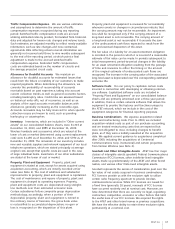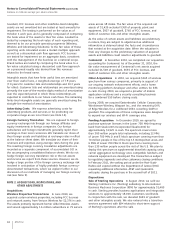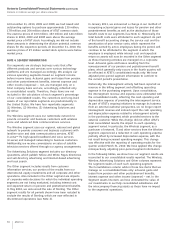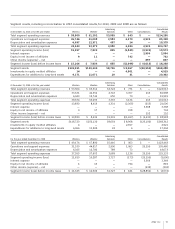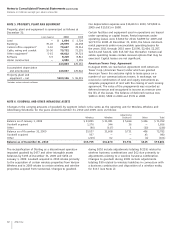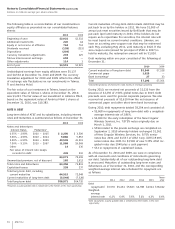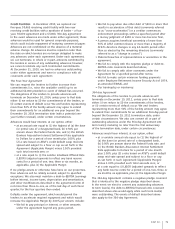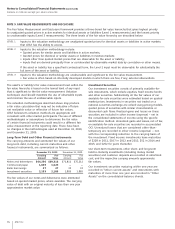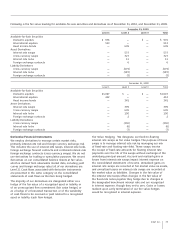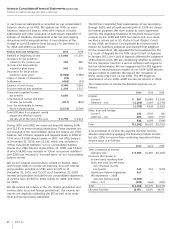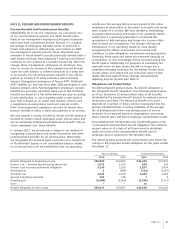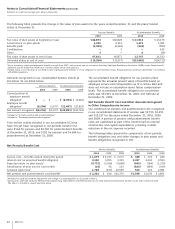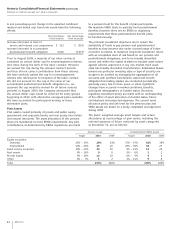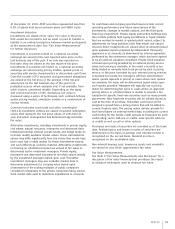AT&T Wireless 2010 Annual Report Download - page 78
Download and view the complete annual report
Please find page 78 of the 2010 AT&T Wireless annual report below. You can navigate through the pages in the report by either clicking on the pages listed below, or by using the keyword search tool below to find specific information within the annual report.
Notes to Consolidated Financial Statements (continued)
Dollars in millions except per share amounts
76 AT&T Inc.
Investment Securities
Our investment securities consist of primarily available-for-
sale instruments, which include equities, fixed income bonds
and other securities. Substantially all the fair values of our
available-for-sale securities were estimated based on quoted
market prices. Investments in securities not traded on a
national securities exchange are valued using pricing models,
quoted prices of securities with similar characteristics or
discounted cash flows. Realized gains and losses on these
securities are included in other income (expense) – net in
the consolidated statements of income using the specific
identification method. Unrealized gains and losses, net of tax,
on available-for-sale securities are recorded in accumulated
OCI. Unrealized losses that are considered other-than-
temporary are recorded in other income (expense) – net,
with the corresponding reduction to the carrying basis of
the investment. Fixed income investments have maturities
of $228 in 2011, $107 in 2012 and 2013, $52 in 2014 and
2015, and $252 for years thereafter.
Our short-term investments, other short- and long-term
held-to-maturity investments (including money market
securities) and customer deposits are recorded at amortized
cost, and the respective carrying amounts approximate
fair values.
Our investment securities maturing within one year are
recorded in “Other current assets,” and instruments with
maturities of more than one year are recorded in “Other
Assets” on the consolidated balance sheets.
The asset’s or liability’s fair value measurement level within the
fair value hierarchy is based on the lowest level of any input
that is significant to the fair value measurement. Valuation
techniques used should maximize the use of observable inputs
and minimize the use of unobservable inputs.
The valuation methodologies described above may produce
a fair value calculation that may not be indicative of future
net realizable value or reflective of future fair values.
AT&T believes its valuation methods are appropriate and
consistent with other market participants. The use of different
methodologies or assumptions to determine the fair value
of certain financial instruments could result in a different fair
value measurement at the reporting date. There have been
no changes in the methodologies used at December 31, 2010,
and December 31, 2009.
Long-Term Debt and Other Financial Instruments
The carrying amounts and estimated fair values of our
long-term debt, including current maturities and other
financial instruments, are summarized as follows:
December 31, 2010 December 31, 2009
Carrying Fair Carrying Fair
Amount Value Amount Value
Notes and debentures $64,256 $69,313 $71,811 $75,212
Commercial paper 1,625 1,625 — —
Bank borrowings 27 27 33 33
Investment securities 2,183 2,183 1,885 1,885
The fair values of our notes and debentures were estimated
based on quoted market prices, where available. The carrying
value of debt with an original maturity of less than one year
approximates market value.
NOTE 9. FAIR VALUE MEASUREMENTS AND DISCLOSURE
The Fair Value Measurement and Disclosure framework provides a three-tiered fair value hierarchy that gives highest priority
to unadjusted quoted prices in active markets for identical assets or liabilities (Level 1 measurements) and the lowest priority
to unobservable inputs (Level 3 measurements). The three levels of the fair value hierarchy are described below:
LEVEL 1 Inputs to the valuation methodology are unadjusted quoted prices for identical assets or liabilities in active markets
that AT&T has the ability to access.
LEVEL 2 Inputs to the valuation methodology include:
•Quotedpricesforsimilarassetsandliabilitiesinactivemarkets;
•Quotedpricesforidenticalorsimilarassetsorliabilitiesininactivemarkets;
•Inputsotherthanquotedmarketpricesthatareobservablefortheassetorliability;
•Inputsthatarederivedprincipallyfromorcorroboratedbyobservablemarketdatabycorrelationorothermeans.
If the asset or liability has a specified (contractual) term, the Level 2 input must be observable for substantially the
full term of the asset or liability.
LEVEL 3 Inputs to the valuation methodology are unobservable and significant to the fair value measurement.
•Fairvalueisoftenbasedoninternallydevelopedmodelsinwhichtherearefew,ifany,externalobservations.



